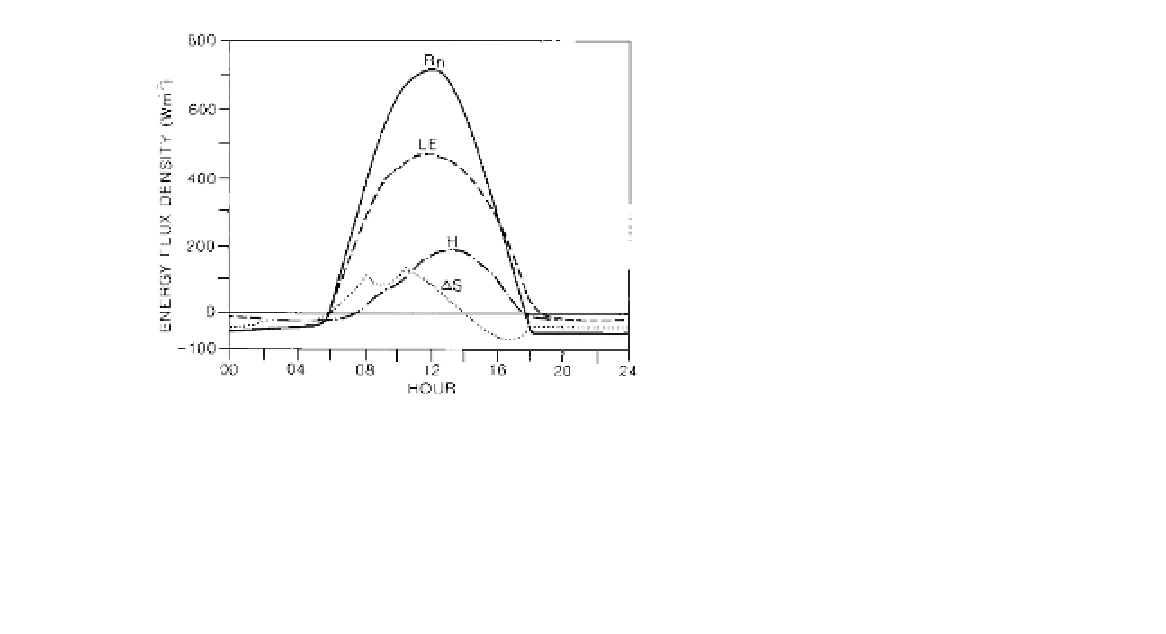Geoscience Reference
In-Depth Information
evapotranspiration, leads to high available energy, high
sensible heat fluxes and the development of a deep
convective planetary boundary layer. This is particularly
marked during spring and early summer due to intense
mechanical and convective turbulence. In autumn, in
contrast, soil freezing increases its heat capacity, leading
to a lag in the climate system. There is less available
energy and the boundary layer is shallow.
The influence of forests on precipitation is still
unresolved. This is due partly to the difficulties of
comparing rain-gauge catches in the open with those
in forests, within clearings or beneath trees. In small
clearings, low wind speeds cause little turbulence around
the opening of the gauge and catches are generally greater
than outside the forest. In larger clearings, downdrafts
are more prevalent and consequently the precipitation
catch increases. In a 25-m high pine and beech forest in
Germany, catches in 12-m diameter clearings were 87
per cent of those upwind of the forest, but the catch rose
to 105 per cent in clearings of 38 m. An analysis of
precipitation records for Letzlinger Heath (Germany)
before and after afforestation suggested a mean annual
increase of 6 per cent, with the greatest excesses occur-
ring during drier years. It seems that forests have little
effect on cyclonic rain, but they may slightly increase
orographic precipitation, by lifting and turbulence, of
the order of 1 to 3 per cent in temperate regions.
A more important influence of forests on precip-
itation is through the direct interception of rainfall by
the canopy. This varies with crown coverage, season
and rainfall intensity. Measurements in German beech
forests indicate that, on average, they intercept 43 per
cent of precipitation in summer and 23 per cent in
winter. Pine forests may intercept up to 94 per cent of
low-intensity precipitation but as little as 15 per cent
of high intensities, the average for temperate pines
being about 30 per cent. In tropical rainforest, about 13
per cent of annual rainfall is intercepted. The intercepted
precipitation either evaporates on the canopy, runs down
the trunk, or drips to the ground. Assessment of the total
precipitation reaching the ground (the through-fall)
requires careful measurements of the stem flow
and the contribution of drips from the canopy. Canopy
interception contributes 15 to 25 per cent of total
evaporation in tropical rainforests. It is not a total loss
of moisture from the forest, since the solar energy
used in the evaporating process is not available to
remove soil moisture or transpiration water. However,
the vegetation does not derive the benefit of water
Figure 12.14
A computer simulation of energy flows involved
in the diurnal energy balance of a primary tropical broad-leaved
forest in the Amazon during a high-sun period on the second dry
day following a 22-mm daily rainfall.
Source
: After a Biosphere Atmosphere Transfer Scheme (BATS)
model from Dickinson and Henderson-Sellers (1988), by permission
of the Royal Meteorological Society, redrawn.
vegetation surfaces also enters into the totals, in addition
to direct transpiration. Calculations made for a catch-
ment covered with Norway spruce (
Picea abies
) in the
Harz Mountains of Germany showed an annual evap-
otranspiration of 34 cm and additional interception
losses of 24 cm.
The humidity of forest stands is linked closely
to the amount of evapotranspiration and increases
with the density of vegetation present. The increase in
forest relative humidity over that outside averages 3
to 10 per cent and is especially marked in summer.
Vapour pressures were higher within an oak stand
in Tennessee than outside for every month except
December. Tropical forests exhibit almost complete
night saturation irrespective of elevation in the trunk
space, whereas by day humidity is related inversely to
elevation. Measurements in Amazonia show that in dry
conditions daytime specific humidity in the lower trunk
space (1.5 m) is near 20 g kg
-1
, compared with 18 g kg
-1
at the top of the canopy (36 m).
Recent research in boreal forests shows that they
have low photosynthetic and carbon draw-down
rates, and consequently low transpiration rates. Over the
year, the uptake of CO
2
by photosynthesis is balanced
by its loss through respiration. During the growing
season, the evapotranspiration rate of boreal (mainly
spruce) forests is surprisingly low (less than 2 mm per
day). The low albedo, coupled with low energy use for


